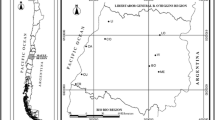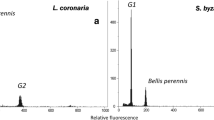Abstract
Cecropia is a pioneer genus from the Neotropics, whilst Macaranga is an ecological analog with a center of distribution in Southeast Asia. In the past few decades, introduced populations of Cecropia spp. have spread rapidly in Singapore, Malaysia, and Indonesia. In Singapore, Cecropia pachystachya now occupies habitats that would have been expected to be occupied by Macaranga gigantea. We conducted germination experiments under 0, 20, 50, and 70 % shading and measured the survival rates and functional traits of the seedlings of these two species from material collected in Singapore. Seeds of C. pachystachya germinated in 3–12 days, whereas seeds of M. gigantea germinated from day 13 onwards. Germination success for C. pachystachya was between 90.3 % under full-light conditions and 55.8 % under 50 % shading, while for M. gigantea only 69.1 % of seed germinated under full-light conditions and germination completely failed when seeds were shaded by 20 % or more. The seedlings of C. pachystachya also had higher survival rates, faster shoot and root biomass accumulation, larger leaves, and lower total water content than those of M. gigantea. Thus overall, C. pachystachya possesses traits that may provide a competitive edge over the native M. gigantea and will be advantageous for its spread given the increasing proliferation of disturbed landscapes in tropical Southeast Asia.

Similar content being viewed by others
References
APG III (2009) An update of the Angiosperm Phylogeny Group classification for the orders and families of flowering plants: APG III. Bot J Linn Soc 161:105–121
Baker HG (1974) The evolution of weeds. Annu Rev Ecol Syst 5:1–24
Bates D, Maechler M, Bolker B (2013) lme4: Linear mixed-effects models using S4 classes. R package version 0.999999-2. http://CRAN.R-project.org/package=lme4
Berg CC (2004) Cecropiaceae. In: Smith et al (eds) Flowering plants of the Neotropics. Princeton University Press, Princeton, pp 92–94
Berg CC, Rosselli PF, Davidson DW (2005) Cecropia. Flora Neotropica Monograph 94:1–230
Bolker BM, Brooks ME, Clark CJ, Geange SW, Poulsen JR, Stevens MHH, White J-SS (2008) Generalized linear mixed models: a practical guide for ecology and evolution. Trends Ecol Evol 24:127–135
Chambers JQ, Negron-Juarez RI, Marra DM, Di Vittorio A, Tews J, Roberts D, Ribeiro GHPM, Trumbore SE, Higuchi N (2013) The steady-state mosaic of disturbance and succession across an old-growth Central Amazon forest landscape. Proc Nat Acad Sci USA 110:3949–3954
Conn BJ, Hadiah JT, Webber BL (2012) The status of Cecropia (Urticaceae) introductions in Malesia: addressing the confusion. Blumea 57:136–142
Daniel AS (1989) Photosynthetic characteristics of a tropical forest understory herb, Alocasia macrorrhiza, and a related crop species, Colocasia esculenta grown in contrasting light environments. Oecologia 86:371–448
Davies SJ (1998) Photosynthesis of nine pioneer Macaranga species from Borneo in relation to life history. Ecology 79:2292–2308
Davies SJ (2001) Systematics of Macaranga sects. Pachystemon and Pruinosae (Euphorbiaceae). Harvard Pap Bot 6:371–448
Davies SJ, Ashton PS (1999) Phenology and fecundity in 11 sympatric pioneer species of Macaranga (Euphorbiaceae) in Borneo. Am J Bot 86:1786–1795
De Souza RP, Válio IFM (2001) Seed size, seed germination, and seedling survival of Brazilian tropical tree species differing in successional status. Biotropica 33:447–457
Evans GC (1972) The quantitative analysis of plant growth. Blackwell Scientific, Oxford
Fiala B, Jakob A, Maschwitz U, Linsenmair KE (1999) Diversity, evolutionary specialization and geographic distribution of a mutualistic ant-plant complex: macaranga and Crematogaster in South East Asia. Biol J Linn Soc 66:305–331
Fine PVA (2002) The invasibility of tropical forests by exotic plants. J Trop Ecol 18:687–705
Gallery RE, Moore DJP, Dalling JW (2010) Interspecific variation in susceptibility to fungal pathogens in seeds of 10 tree species in the neotropical genus Cecropia. J Ecol 98:147–155
Kaplan EL, Meier P (1958) Nonparametric estimation from incomplete observations. J Am Stat Assoc 53:457–481
Körner C, Renhardt U (1987) Dry matter partitioning and roof length/leaf area ratios in herbaceous perennial plants with diverse altitudinal distribution. Oecologia 74:411–418
Lambdon PW, Lloret F, Hulme PE (2008) Do alien plants on Mediterranean islands tend to invade different niches from native species? Biol Invasions 10:703–716
Lok AFSL, K-x Tan, Chong KY, Nghiem TPL, Tan HTW (2010) The distribution and ecology of Cecropia species (Urticaceae) in Singapore. Nat Singap 3:199–209
Lowe S, Browne M, Boudjelas BS, De Poorter M (2004) 100 of the world’s worst invasive alien species: A selection from the Global Invasive Species Database. Invasive Species Specialist Group, Species Survival Commission, World Conservation Union (IUCN)
Machin D, Chueng YB, Parmar MKB (2006) Survival analysis: a practical approach, 2nd edn. Wiley, Cambridge
Martin PH, Canham CD, Marks PL (2009) Why forests appear resistant to exotic plant invasions: intentional introductions, stand dynamics, and the role of shade tolerance. Front Ecol Environ 7:142–149
McKey D (1988) Cecropia peltata, an introduced Neotropical pioneer tree, is replacing Musanga cecropioides in Southwestern Cameroon. Biotropica 20:262–264
Miettinen J, Shi C, Liew SC (2011) Deforestation rates in insular Southeast Asia between 2000 and 2010. Global Change Biol 17:2261–2270
Muñoz MC, Ackerman JD (2011) Spatial distribution and performance of native and invasive Ardisia (Myrsinaceae) species in Puerto Rico: the anatomy of an invasion. Biol Invasions 13:1543–1558
R Core Team (2012) R: A language and environment for statistical computing. R Foundation for Statistical Computing, Vienna
Raich JW, Gong WK (1990) Effects of canopy openings on tree seed germination in a Malaysian dipterocarp forest. J Trop Ecol 6:203–217
Randall RP (2002) A global compendium of weeds. R. G. and F. J, Richardson
Richardson DM, Pyšek P, Carlton JT (2011) A compendium of essential concepts and terminology in invasion ecology. In: Richardson DM (ed) Fifty years of invasion ecology: the legacy of Charles Elton. Blackwell Publishing Ltd, Chichester, pp 409–420
Silander SR, Lugo AE (1990) Cecropia peltata L. In: Burns RM, Honkala BH (eds). Silvics of North America: 2. Hardwoods. Agriculture Handbook 654. US Department of Agriculture, Forest Service, Washington, DC. http://www.na.fs.fed.us/spfo/pubs/silvics_manual/volume_2/cecropia/peltata.htm
Slik JWF (2005) Assessing tropical lowland forest disturbance using plant morphological and ecological attributes. Forest Ecol Manag 205:241–250
Slik JWF, Verburg RW, Keβler PJA (2002) Effects of fire and selective logging on the tree species composition of lowland dipterocarp forest in East Kalimantan, Indonesia. Biodivers Conserv 11:85–98
Stricker KB, Stiling P (2013) Seedlings of the introduced invasive shrub Eugenia uniflora (Myrtaceae) outperform those of its native and introduced non-invasive congeners in Florida. Biol Invasions 15:1973–1987
Teo DHL, Tan HTW, Corlett RT, Wong CM, Lum SKY (2003) Continental rain forest fragments in Singapore resist invasion by exotic plants. J Biogeog 30:305–310
Therneau T (2012) coxme: Mixed effects Cox models. R package version 2.2-3. http://CRAN.R-project.org/package=coxme
Tilman D (1988) Plant strategies and the dynamics and structure of plant communities, vol 26. Princeton University Press, Princeton
Van Kleunen M, Weber E, Fischer M (2010) A meta-analysis of trait differences between invasive and non-invasive plant species. Ecol Lett 13:235–245
Whitmore TC (1984) Tropical rain forests of the Far East, 2nd edn. Oxford University Press, Oxford
Whitmore TC, Ashton PS, Davies SJ, Lock JM, McPherson G, Pennington TD (2008) The genus Macaranga: A prodromus. Royal Botanic Gardens, Kew
Acknowledgments
We would like to thank Stuart Davies for advice on the collection of M. gigantea seeds and the National Parks Board, Singapore, for permission to make the seed collections, under permit number RP11-038.
Author information
Authors and Affiliations
Corresponding author
Additional information
Communicated by Claus Holzapfel.
Rights and permissions
About this article
Cite this article
Raphael, M.B., Chong, K.Y., Yap, V.B. et al. Comparing germination success and seedling traits between exotic and native pioneers: Cecropia pachystachya versus Macaranga gigantea . Plant Ecol 216, 1019–1027 (2015). https://doi.org/10.1007/s11258-015-0486-4
Received:
Accepted:
Published:
Issue Date:
DOI: https://doi.org/10.1007/s11258-015-0486-4




